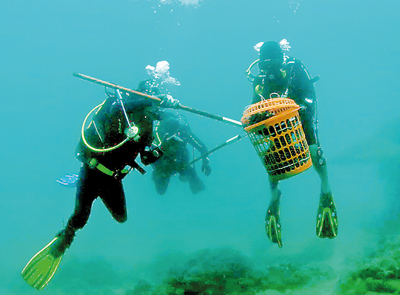Operation starfish to save reef
Armed with improvised spears, the team clad in scuba gear, were submerged in the clear waters off Pigeon Island. Seeing an area where corals were destroyed, they descended like sharks that had spotted their prey. Taking aim, they speared the starfish that was the cause of the destruction.

The thorny interloper: Starfish that have been removed from the coral reef
Pigeon Island is one of Sri Lanka’s two Marine National Parks and it is prohibited to hunt any creature in this sanctuary. But Wildlife Officers too supported this mission as the ‘Crown of Thorn Starfish’ are extremely destructive to the corals, feeding on the microorganism polyps that build them. According to marine biologists, the number of COT in the Pigeon Island reef began increasing last year exceeding the threshold of their natural occurrence, hence the need for action to control the damage.
“We came to know about the outbreak at Pigeon Island and as conservation oriented underwater explorers, we wanted to organise a programme to remove the COTs on Pigeon Island Coral Reef,” Upekshi Perera, President of the Sub Aqua Club said.
It was no easy task as some of these creatures are hidden inside the corals. The starfish also has protective thorns that are venomous. The recommended method of removing the COTs is by injecting Sodium bi-sulphate using syringes with long needles, but the team had to come up with other methods.
Travice Ondatje of Nilaweli Beach Hotel who is also a member of Sub Aqua Club was the mastermind behind creating the team’s main weapon – the ‘broomstick spear’. “It was simply a broomstick with a five millimetre steel rod (used for concrete) tied to one end,” Travice said. The team had taken time to learn how to manoeuvre the improvised spear.
The team comprised 12 divers from the Sub Aqua Club and three from the Ypsylon Dive Centre that also provided some of the dive equipment. Forming three teams, they had done two dives – each taking one and half hours. Teams moved in semi circles inspecting the corals on the southern part of the reef. One diver held ‘plastic laundry bins’ to collect the starfish speared by the other members.

The team fills up buckets of Crown of Thorn starfish
At the end of the day, the team had removed 181 Crown of Thorn Starfishes – double the number we thought we could achieve, said Dharshana Jayawardane, dive officer of Sub Aqua Club. The density of the COT on top of stag horn corals was more, he added.
Dr. Malik Fernando, an expert on Sri Lanka’s marine life and founder member of the Sub Aqua Club said there are COT outbreaks once in a while and intervention is required to manage them. Coral ecologist Arjan Rajasuriya praised the work done by the Sub Aqua Club members highlighting the need for such an exercise annually. Government agencies should organise a programme to facilitate volunteers as diving is a costly exercise, he said.
The worst outbreaks were in the 1970s and early 80s. Not only the East coast, but many other areas too have been infested and thousands of COTs had been removed under the guidance of Dr. de Bruin, a Research Officer attached to the Department of Fisheries, Mr. Rajasuriya said.
Mr. Rajasuriya said that there can be various reasons for a COT outbreak. More nutrients in the water and removal of fish that prey on COT and also the warming oceans could provide optimal conditions for COT larvae to thrive.
Upekshi further added that Pigeon Island is a tourist attraction and unless we take care of such habitats, there will be nothing to showcase in time to come. She was grateful for the support that Nilaweli Beach Hotel and Ypsylon Dive Centre gave them. The Sub Aqua Club is planning to do this as an annual event, she said, happy that they had done their bit for Pigeon Island.
Coral monitoring programme needed
According to IUCN Red Data, Corals are one of the most threatened species in the world. Corals are useful for many reasons even in breaking the power of unexpected sea surges such as a Tsunami. Some years ago NARA had a coral- monitoring programme and NARA chairman Dr. Sayuru Samarasundara said the agency plans to re-commence it next year.
Know the enemy
The crown-of-thorns (Acanthasterplanci) receives its name from venomous thorn-like spines that cover its upper surface like the crown of thorns placed on the head of Jesus. An adult starfish can grow up to 35 cm (14 in). They usually have 21 arms but this number can change from population to population, points out Arjan Rajasuriya.
Their spines are stiff and very sharp. The adult crown-of-thorns is a carnivorous predator that usually preys on reef coral polyps. It climbs onto a section of living coral using its large number of tube feet and flexible body and fits closely to the surface of the coral, even the complex surfaces of branching corals. It then extrudes its stomach out through its mouth over the surface to virtually its own diameter.
The stomach surface secretes digestive enzymes that allows the starfish to absorb nutrients from the liquefied coral tissue. This leaves a white scar on the coral skeleton which is rapidly infested with filamentous algae.
An individual starfish can consume up to six square metres (65 sqft) of living coral reef per year according to Wikipedia.
comments powered by Disqus

